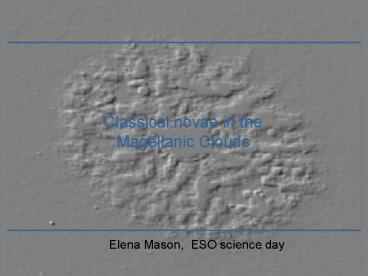Classical novae in the Magellanic Clouds - PowerPoint PPT Presentation
1 / 12
Title:
Classical novae in the Magellanic Clouds
Description:
Classical novae in the Magellanic Clouds. Elena Mason, ESO science day ... He/N 2500 km/s flat topped/jagged days, neon [Ne V,III] coronal [FeX,VII] no lines ... – PowerPoint PPT presentation
Number of Views:75
Avg rating:3.0/5.0
Title: Classical novae in the Magellanic Clouds
1
Classical novae in the Magellanic Clouds
Elena Mason, ESO science day
2
(No Transcript)
3
ToO
Light curve t2 t3
Spectral evolution at various/different phases
4
Cerro Tololo classification
(Williams et al. 1991, 1994)
line profile
type
HWZI
evolution nebular spc
FeII lt2500 km/s P-Cyg weeks,
standard
NII,OII,III
He/N gt2500 km/s flat topped/jagged days,
neon Ne V,III
coronal
FeX,VII
no lines
FeIIb broad lines, fast evolution as the He/N
type
5
two populations of novae in the MilkyWay
(Della Valle Livio 1998)
- fast bright novae MV-9, t2lt12d, t3lt20d
- He/N type, low galactic latitude, massive WD,
PopI - slow faint novae MV-7.5, t2gt12d, t3gt20-25d
- FeII type, high glactic latitude, MWD1 Msun ,
PopII
6
Nova SMC
2001
FWHM lt 1900 km/s t2 20d
7
t212d
Nova LMC 2002
FWHM 2100 km/s
8
distance is known LMC51.4 kpc SMC56.4
kpc
OI HII mass
OI
t
OI line flux ratio
9
HII
filling factor
10
FeII type
He/N type
11
Conclusion
Some of the general physical properties of the
two novae are comparable to those of galactic
novae. LMC nova population is missing of the
slow faint component. FeII type novae can
have either fast or slow decline. LMC novae have
larger fraction of fast FeII type novae than the
MilkyWay. (Larger birghtness and larger amount
of ejected mass are expected at low metallicity
regimes.)
12
Nova Oph 2004































